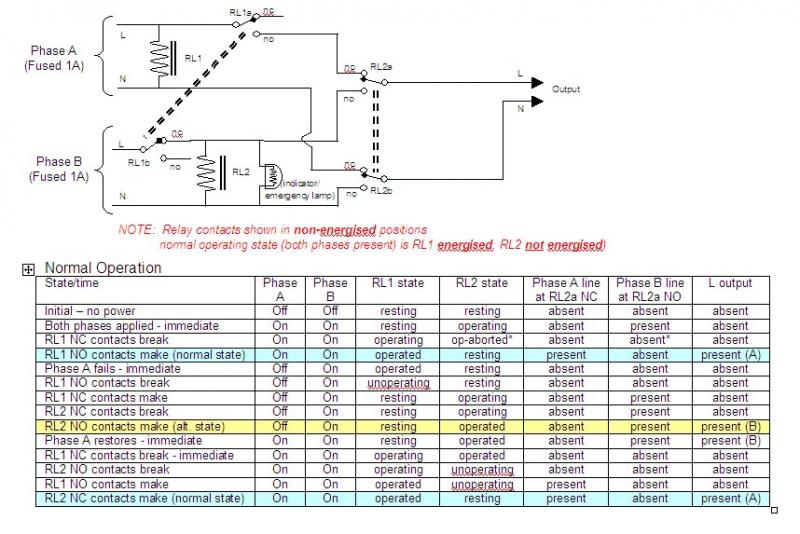I'll look out the circuit diagram. I remember that it was far from easy, and that I was not even totally comfortable with the end result. IIRC, the main problem occurs 'at energisation'.....
OK, here’s the present arrangement I have for
MY application (not the OP’s) for switching a small load to an alternative phase (of a single 3-phase supply) in the event of failure of the usual phase:
For the primary ‘interlocking’, I rely on the intrinsic ‘interlock’ functionality of changeover relay contacts. The risk of doing this is obviously that of arcing between (or fault-produced contact between) the two fixed contacts, if they are (as they would be in the simplest arrangement) connected to different phases. However, assuming I’ve got it all right (see table above), the logic of my control arrangement is such that, in all normal operating conditions (including loss and return of the primary phase), both phases are never connected to a set of relay RL2’s changeover contacts simultaneously. This also remains true if relay RL1 fails to operate (or its contacts stick in NC position) or if its contacts remain stuck in the NO position. Failure of RL2 to operate, or sticking of its contacts in either position, has no ‘safety’ implications (although will obviously affect functionality).
In the absence of any faults, the only situation in which both phases could appear on their respective contacts of relay RL2 is very transiently during power-up (of both phases simultaneously), should RL2 change state before RL1 removed the supply to its coil. However, that probably wouldn’t happen and, even if it did, would require an extremely improbably concurrent other fault/issue to result in any problem.
There do, of course, remain some theoretically possible, but very improbable, failure modes - most, if not all, involving faults in the changeover relay itself. However, both phases are supplied from their own dedicated 6A RCBOs and also supplied via 1A (not 3A as I previously said) fuses, and I would imagine/hope that at least one of these devices would operate before anything nastier happened in the event of any of the possible fault conditions. There is also (not shown in above diagram) a relay across the output of RL2 which causes a (battery-powered) alarm to sound should the load receive no power from either phase.
I really am pretty comfortable with this arrangement, but I’m sure that some of you will have some comments, and quite possibly reservations, about it! Posting ‘what one has done’ is always dangerous

I imagine that it's asking far too much to even hope that no-one will find any fault with it

Kind Regards, John



